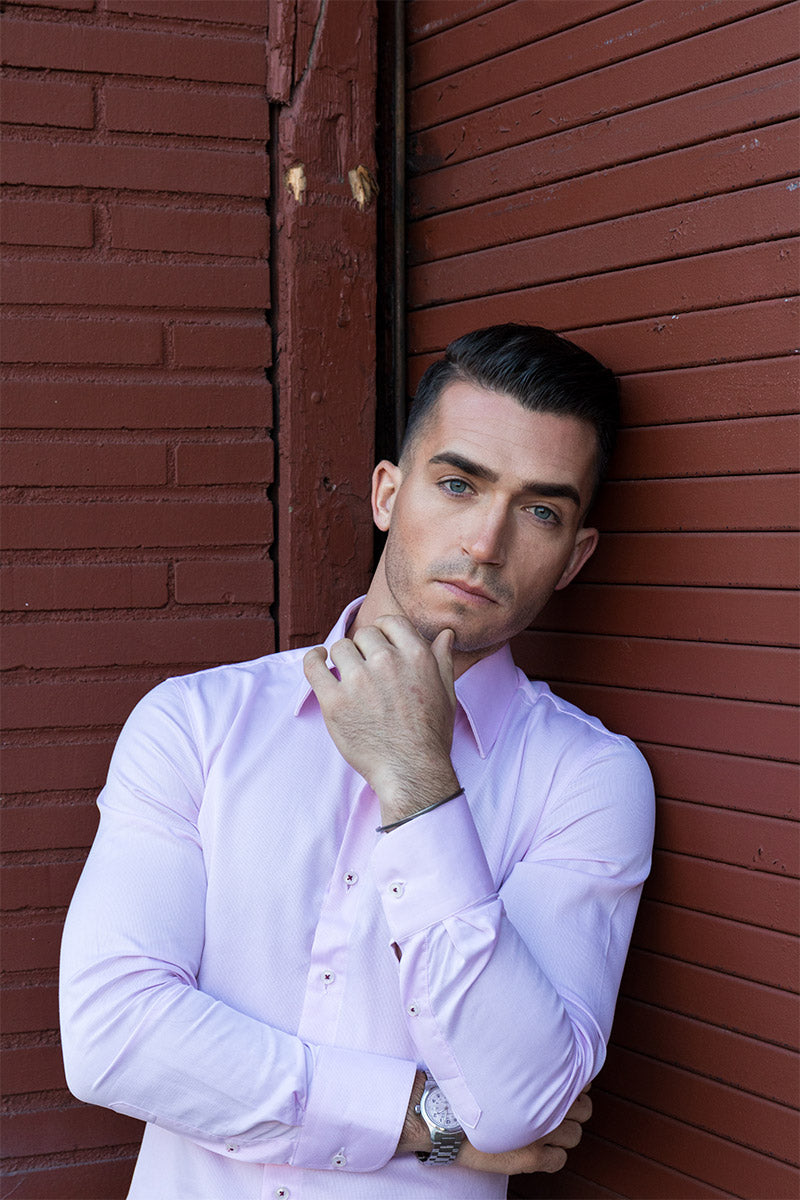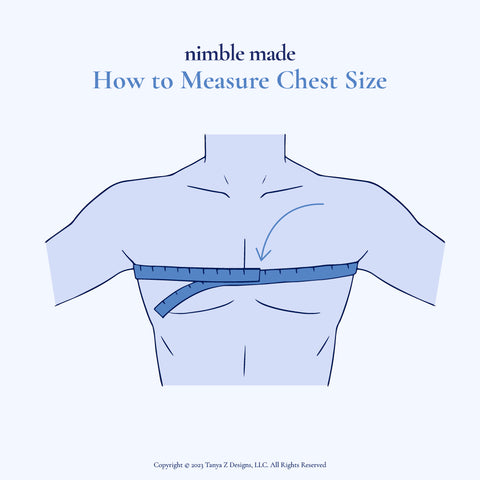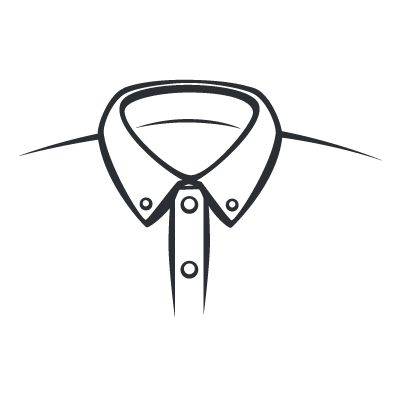
Written by Ben Chuang
Not all dress shirts are created equal. Technically, any shirt with collars and buttons may fall under the broad umbrella of "dress shirt," but many different categories of shirts exist within this spectrum.
As a man who tends to maintain a minimal-ish wardrobe, I still like to own a decent variety of shirts in terms of formality, pattern, color, and texture, so that I can put together an appropriate outfit for any number of occasions.
Read on to learn what are the different types of dress shirts for men, and which ones you want to have in your wardrobe.

Which Shirts Are Considered Dress Shirts?
Of course, to discuss men’s dress shirts, the first thing to know is what is necessary for a shirt to be considered dressy. Tee shirts aren’t dressy. Although wearing a polo shirt has become acceptable in many workplaces, they are also not dressy, so save them for the golf course or situations where business casual attire is acceptable.
For those of you living in really hot environments, a lot of places may let you get away with a short-sleeved button-down, Henley shirt, or polo shirt. These are considered acceptable attire in many business environments now, and even some weddings. However, this does not qualify them formally as dress shirts. Long sleeves are mandatory for a shirt to be considered a dress shirt.
This begs the question of what else is necessary for a shirt to be considered dressy if it isn’t related to style or culture? In short, a men’s dress shirt is a long-sleeved, button-up shirt with a collar. The shirt needs to be able to accommodate a tie and be worn under a jacket, even if the occasion doesn’t require either of them.
If you're in the market for one, read this helpful guide on how to buy a dress shirt.
Introduction to Men’s Dress Shirt Styles
When it comes to men's fashion, dress shirts are an essential wardrobe staple when it comes to how to dress like a man, providing versatility and style for a variety of occasions.
Understanding the different types of dress shirts can help men make informed choices, ensuring they look sharp and appropriate, whether in a job interview, a casual outing, or a formal event.
Dress shirts can broadly be categorized into formal and more casual shirt styles, each with its own unique characteristics and suitable occasions.
Formal dress shirts are designed with a polished, sophisticated look in mind. These shirts typically feature high-quality fabrics, such as cotton poplin or Oxford, and come in classic colors like white, light blue, and pastel shades like this light purple shirt.
They often have structured collars, like spread or point collars, and can include details such as French cuffs for added elegance. Formal dress shirts are perfect for business settings, weddings, and other special events where a professional appearance is paramount.
On the other hand, casual dress shirts offer a more relaxed vibe, often incorporating softer fabrics like linen or oxford cloth and a wider range of colors and patterns.
These shirts may have button-down collars and are versatile enough to be worn untucked or with a more relaxed fit, making them ideal for casual Fridays, social gatherings, or a laid-back weekend look.
Formal Dress Shirts
Formal dress shirts are distinguished by their high-quality fabrics and meticulous construction, which contribute to their polished and professional appearance. Typically made from premium cotton materials like poplin, twill, or broadcloth, these bestselling shirts offer a smooth, crisp finish that holds its shape well throughout the day.
The fabric choice not only enhances comfort but also ensures durability and a refined look. In terms of color, formal dress shirts often stick to classic hues such as white, light blue, and subtle pastels, which are versatile and easy to pair with various suit colors and ties.
The design details of formal dress shirts further set them apart. They feature structured collars, such as spread or point collars, that maintain a sharp, clean line, even when worn with a tie. French cuffs, which require cufflinks, add a touch of elegance and sophistication, making these shirts suitable for high-end events and formal settings.
Additionally, formal dress shirts typically have a full-length button placket and may include features like pleated backs or darts for a more tailored fit, enhancing the overall silhouette.
Fit and construction are paramount in formal dress shirts, emphasizing a streamlined and flattering appearance. These shirts are designed to be worn tucked in, providing a neat and tidy look that complements black tie attire.

The fit can vary from the classic fit, which offers more room for movement, to slim and modern fits that provide a more contemporary, tailored look.
Regardless of the specific fit, the key is to ensure the shirt hugs the body comfortably without excessive bagginess or tightness, thus maintaining a professional and sophisticated demeanor suitable for any formal occasion.
Casual Dress Shirts
Casual dress shirts are designed for versatility and comfort, striking a balance between relaxed style and polished appearance. Typically made from softer, more breathable fabrics such as linen, chambray, or oxford cloth, these linen dress shirts are perfect for laid-back settings while still maintaining a refined look.
Casual dress shirts come in a wider range of colors and patterns compared to their formal counterparts, including gingham, flannel, and prints, allowing for more personal expression and variety in casual wear.
The design of casual dress shirts often includes features that enhance their relaxed vibe. Button-down collars are a common feature, adding a sporty touch and ensuring the collar stays in place without the need for a tie.
Casual dress shirts may also have shorter sleeves or rolled-up sleeves, making them suitable for warmer weather and more informal occasions such as going to the country club. They often include chest pockets, which add a functional and stylistic element, further distinguishing them from the more streamlined design of formal shirts.
Fit and flexibility are key characteristics of casual dress shirts. Unlike formal shirts, which are meant to be tucked in, casual dress shirts can be worn untucked, offering a more relaxed silhouette that works well with jeans, chinos, or shorts.

The fit can vary from slim to relaxed, catering to different body types and personal preferences. The overall design is intended to provide comfort and ease of movement, making casual dress shirts a versatile choice for activities ranging from weekend outings to casual office environments.
The combination of comfort, style, and functionality makes the casual shirt a staple in any modern wardrobe.
Fit: How a Men’s Dress Shirt Should Look on Your Body
When selecting a dress shirt, the fit is crucial for achieving the desired look and comfort. Classic fit and slim fit are two popular options that cater to different body types and style preferences. Modern fit, also known as tailored fit, strikes a balance between the loose, traditional cuts and the tighter slim fit.
It offers a slightly tapered cut that contours to the body without being too tight, providing a clean and contemporary silhouette. This fit is versatile and suits a wide range of body types, offering comfort and style without compromising on professionalism.
Modern-fit shirts are ideal for those who want a sharp, modern appearance without the constriction of a slim fit.
In contrast, slim-fit dress shirts are designed for a more fitted, streamlined look. They are cut closer to the body, particularly in the chest, waist, and sleeves, creating a sleek and modern silhouette.
Slim-fit shirts are best suited for individuals with lean or athletic builds, as they emphasize a narrow waist and broader shoulders. This fit is perfect for those who prefer a more contemporary and fashion-forward style, often pairing well with slim-fit suits and trousers.
While they offer a stylish and polished appearance, slim-fit shirts can be less forgiving and may feel restrictive for those with broader or more athletic builds.
The fit of a shirt is just as important as the accouterments when it comes to formal versus casual shirts. A sloppy shirt will quickly drag down even the nicest of dress shirts. We have a full guide on how should a dress shirt fit.

Most men don’t wear shirts that properly fit their bodies, because they don’t have each of their shirts tailored. Off-the-rack clothing is quick and convenient, so the fit won’t always be perfect. Just make sure it’s within decent parameters.
If you're a shorter guy, check out these dress shirts for short men.
Proper Torso Fit
A dress shirt should fit your torso in a way that balances comfort with a sharp, tailored appearance. The shoulders are the foundation of a well-fitting shirt; the shoulder seams should align perfectly with the edge of your shoulders, creating a clean line that doesn’t droop or pull.
This ensures that the shirt sits correctly on your body and allows for a full range of motion without feeling tight or restrictive. A properly fitting shoulder area sets the stage for the rest of the shirt to follow the contours of your torso smoothly.

Moving down to the chest measurement, the shirt should provide a close fit without being overly tight. When buttoned up, the fabric should lie flat against your chest without creating any gaping or strain around the buttons, which indicates the shirt is too tight.
Conversely, there shouldn't be excess fabric billowing out at the waist measurement, which would suggest the shirt is too loose. A well-fitted dress shirt will gently taper from the chest to the waist, following the natural shape of your body and providing a streamlined look.
This tapering helps to avoid a boxy appearance and ensures the shirt looks sharp whether tucked in or worn untucked.
Finally, the length of the shirt hem is crucial for maintaining a polished look. A dress shirt should be long enough to stay tucked in throughout the day, which generally means the hem should fall a few inches below your belt line.

If you prefer wearing your shirt untucked, ensure it is short enough to avoid looking sloppy, usually ending just past your hip bones. The back of the shirt should be slightly longer than the front to accommodate movement without coming untucked.
Overall, the fit should create a smooth, continuous line from the neck to the hem, avoiding any excessive fabric bunching or pulling, which ensures both comfort and a refined, professional appearance.
A dress shirt should never be loose or baggy. It should fit your torso like a glove, with the buttons laying flat on your chest. Don’t wear a shirt with buttons that are struggling to open and showing skin - those are too tight.
On the other hand, don’t wear a shirt where the buttons are loose and the shirt is bagging up around your waist. The right fit on a man’s dress shirt will allow your buttons to lie flat and give you enough room to breathe and stretch without sagging material which are issues our shirts resolve. See below for a perfect-fitting shirt:
The Right Sleeve Length
The sleeve length and cuff style will vary based on the type of shirt you’re wearing and whether or not you need to add a jacket to your look. A lot of dress shirts have 6 buttonholes instead of 4 to accommodate changes in arm lengths and cuffing.

Your cuffs should never extend past your wrists, no matter what you wear over the shirt. You want those cuff links to be visible accessories, not obstructions to handshakes.
Collar Styles and Cuff Pairings
The most visible style variances in men’s dress shirts are in the collars. Each type of collar is appropriate for different occasions, so you need to make sure your tie, cuff, and collar match the event you’re attending.
Forward Point Collar
One of the most formal type of collar is the forward point collar, which is commonly referred to as the straight point collar. This is also the most traditional collar type. It has a very narrow collar and looks best when worn under a suit and tie. The collar point is long and the tips are very close when compared to other shirts.
The point collar is also one of the more versatile collar types. It can fit equally well in a business meeting or black-tie gala. For this collar, small or medium tie knots and round or angled cuffs look best.
Short Semi-Spread Collar

If your shirt has shorter points that are wider apart, you’ve got a semi-spread. This is a more casual look, but thanks to changes in social trends it can still be worn during formal occasions. This is a great option for long-necked men.
This look works well with a Windsor knot on the tie. Because of the wider spread, you can get fancy with larger tie knots. Pair this shirt with rounded or angled cuffs.
Cutaway Collar

One of the smallest collar point lengths can be found on the cutaway collar, so if you don’t like tips then this is the collar for you. The tips are short and spread really wide.
This shirt has become very popular among modern gentlemen because of the sophisticated look, but it’s not ideal for workwear if your office is extremely formal because you will be able to see some of the collar underneath the tie.
This shirt compliments angled faces because the sharpness of the band will soften your edges. Pair this shirt with large knots like the Windsor for a more traditional look, but if you want to play into the sophistication of the shirt then try a Trinity, Balthus, or Eldredge knot instead. This shirt should only be worn with straight cuffs.
Spread Collar

If you want to wear a dress shirt in a casual or work setting, then the spread collar is your best bet. It’s not super formal and isn't disqualified from being worn at work.
It’s a modern and elegant look that is commonly seen in many work environments today. The collar is versatile enough to work with nearly every tie knot you choose.
This collar is well balanced and versatile. It can be worn in nearly every situation, and by nearly any facial type. You can use straight or rounded cuffs with it.
Long Button-Down Collar

This collar makes for a less formal dress shirt. Again, this is a great shirt to wear in more casual situations for a sharper look than just a t-shirt.
The tips of this collar have button holes that fasten them to the shirt. Originally, this look was developed for sportswear, but thanks to changing societal trends it has now found a home among casual and informal business outfits and is extremely popular with young men.
This look is rarely paired with a tie because of its casual nature. Pair it with a sports jacket or a tailored blazer if you want to dress it up a bit. Angled cuffs work best with this sporty collar.
Short Button Down Collar

Young men and teenagers who need a dress shirt might enjoy the short button-down shirt. The tips of this collar are very short, but still button down. This medium collar looks great on Oxford shirts because it blends classic and modern collar styles. These are our favorite button down shirts for slim guys.
This shirt should be paired with a jacket or blazer. Avoid wearing a tie with it unless necessary. The angled cuff is still the right choice for this shirt.
Round Collar

A popular 1920s style that is seeing a resurgence in popularity is the round collar. This collar features rounded tips, which is where it gets its name. Another name for it is the club collar. This collar was an exclusive look for wealthy English school uniforms.
Men with long faces will look great in this collar, but if you’ve got a rounder face, steer clear. This shirt goes well with very thin ties and knits. To make this shirt more casual, leave the collar open or wear it under a sweater. Rounded cuffs look best with this.
Band Collar

If you want to give a nod to Eastern fashion, then consider a band collar. These don’t have any points. These shirts have a 3cm high band around the neck with a front button. Because of its minimal design, it can be worn for special events, whether or not you include a jacket. This shirt requires rounded cuffs and cannot be worn with a tie.
Wingtip Collar

The wingtip collar is the most formal style of men’s dress shirt available and was designed to be worn with one of the best tuxedo shirts. The point lengths are very short and don’t even reach the bottom of the collar.
Although this originated as a business shirt, today’s culture sees it used almost exclusively in black-tie galas. This collar style is paired with a tailcoat or tuxedo.
The style of the shirt is designed for use with a bowtie only. Trying to wear a tie with this shirt will look silly. The French cuff is the only cuff for this shirt because of how formal it is, but you can choose between double or rounded styles. You must wear cufflinks.
Dress Shirt Cuffs
Dress shirt cuffs are a critical element that can significantly influence the overall style and formality of a shirt. The two most common types of cuffs are French cuffs and barrel cuffs, each offering distinct characteristics and suited to different occasions.
Understanding these differences can help you choose the right dress shirt for any event, from formal gatherings to casual outings.
French Cuffs
French cuffs are the epitome of elegance and sophistication, typically found on the most formal dress shirts. These cuffs are double-length and require folding back before being fastened with cufflinks, rather than buttons. The need for cufflinks provides an opportunity for personal expression and adds a touch of luxury and refinement.
French cuffs are ideal for black-tie events, weddings, and high-end business settings, where a polished and professional appearance is essential. Their design inherently commands attention and complements a well-tailored suit, enhancing the overall formal attire.
Barrel Cuffs
On the other hand, barrel cuffs are more versatile and common, featuring a straightforward design with one or two buttons for fastening. This type of cuff is generally more convenient and practical for everyday wear, making it suitable for both professional and casual environments. Barrel cuffs provide a clean and neat appearance without the need for additional accessories like cufflinks.
They come in various styles, including single-button and double-button versions, and are often adjustable to ensure a comfortable fit. While they lack the opulence of French cuffs, barrel cuffs offer flexibility and ease of use, making them a go-to choice for a wide range of dress shirts, from office wear to casual outings.
Frequently Asked Questions about Types of Dress Shirts
What type of dress shirt for suit?
When choosing a dress shirt to wear with a suit, opt for a classic, well-fitted shirt in a solid color or subtle pattern. White and light blue are versatile choices that complement most suits, while a striped shirt can add a touch of personality without being overly bold. Look for shirts made of high-quality cotton with a smooth finish, such as twill or poplin, and ensure they have a structured collar, such as a spread or point collar, to maintain a sharp and professional appearance.
What are dress up shirts called?
Dress-up shirts, commonly referred to as dress shirts, are tailored shirts typically worn for formal or semi-formal occasions. These shirts feature a structured collar, button-up front, and long sleeves with cuffs that may accommodate cufflinks. Dress shirts are designed to be worn tucked into trousers and often paired with suits or blazers, making them a staple in business and formal attire.
What are the different types of fit for shirts?
Shirts come in various fits to accommodate different body types and style preferences. The main types of fits are slim fit, tailored fit, and classic fit. Slim fit shirts are cut close to the body, providing a modern, streamlined look. Tailored fit, also known as fitted or athletic fit, offers a slightly looser cut than a slim fit shirt but still follows the contours of the body, offering a balance between comfort and style. A classic fit dress shirt is the most traditional, offering a roomy cut that provides maximum comfort and ease of movement.
What type of shirt for office?
For office wear, choose a dress shirt that combines professionalism with comfort. A classic cotton dress shirt in solid colors like white, light blue, or pastel shades is a safe choice, as these colors are versatile and easy to pair with suits or dress pants. Subtle patterns like pinstripes or checks can also be appropriate, provided they are not too bold. Ensure the shirt has a good fit—either slim, tailored, or classic, depending on your body type and preference—and opt for a collar style that complements your suit or tie as well as the occasion.






Comments (0)
Back to News